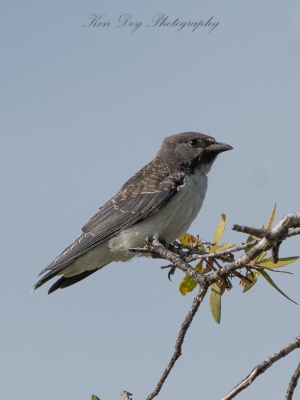Alternative names: White-breasted Swallow-Shrike; White-rumped Woodswallow; Lesser Woodswallow
- Artamus leucorynchus
Identification
18.5cm (7¼ in)
- Dark slaty grey to blackish-grey or dark brownish grey head, chin, throat and upperparts
- White rump and uppertail-coverts
- Blackish tail (without white terminal tail-band like Ashy Woodswallow)
- White to creamy-white underparts
- Dark brown eye
- Pale blue-grey bill with black tip
Sexes similar. Juveniles are more dark brownish with pale feather tips above and sometimes washed light buff underparts.
The subspecies differ mainly in the darkness of the upperparts.
Similar species
Great Woodswallow of New Guinea is bigger, darker and has a diagnostic white patch on the inner leading of the wing.
Distribution
From the Andaman Islands east through peninsular Malaysia, Sumatra, Borneo, Java, the Philippines and New Guinea to northern and eastern Australia and to New Caledonia.
Widespread and locally common.
Taxonomy
May form a superspecies with Ivory-backed Woodswallow, Great Woodswallow and Bismarck Woodswallow.
Subspecies
Nine subspecies are recognized[1]:
- A. l. humei on Coco Islands (Burma) and Andaman Islands (India)
- A. l. leucorynchus in the Philippines, Sulu Islands, Natuna Islands and Borneo
- A. l. pelewensis on Palau Islands
- A. l. amydrus on Sumatra, peninsular Malaysia, Java and Bali
- A. l. musschenbroeki on Babar and Tanimar Islands (Indonesia)
- A. l. leucopygialis in the Moluccas, New Guinea and north and east Australia
- A. l. tenuis on Banks Islands and Vanuatu
- A. l. melaleucus on New Caledonia and Loyalty Islands
Habitat
Common, from open country to clearings at forest edge up to 500m, sometimes up to 1500m. Often seen near habitation, also attends herds of water buffalo or cattle.
Behaviour
Diet
Feeds on insects which are caught on the wing.
Often seen perched before hunting. Forages singly or in small groups.
Breeding
Co-operative breeding recorded. the nest is a cup made of sticks and grass. It's placed in a tree fork, a hollow branch or in an artifical structure (eg fence post). Lays 3 - 4 eggs.
Movements
A mainly resident species. In parts of its range nomadic and some north-south migratory movements recorded in Australia.
References
- Clements, J. F., T. S. Schulenberg, M. J. Iliff, S. M. Billerman, T. A. Fredericks, B. L. Sullivan, and C. L. Wood. 2019. The eBird/Clements Checklist of Birds of the World: v2019. Downloaded from http://www.birds.cornell.edu/clementschecklist/download/
- Rasmussen, PC and JC Anderton. 2005. Birds of South Asia: The Ripley Guide. Barcelona: Lynx Edicions. ISBN 978-8487334672
- Del Hoyo, J, A Elliott, and D Christie, eds. 2009. Handbook of the Birds of the World. Volume 14: Bush-shrikes to Old World Sparrows. Barcelona: Lynx Edicions. ISBN 978-8496553507
Recommended Citation
- BirdForum Opus contributors. (2024) White-breasted Woodswallow. In: BirdForum, the forum for wild birds and birding. Retrieved 27 July 2024 from https://www.birdforum.net/opus/White-breasted_Woodswallow
External Links
GSearch checked for 2020 platform.1







